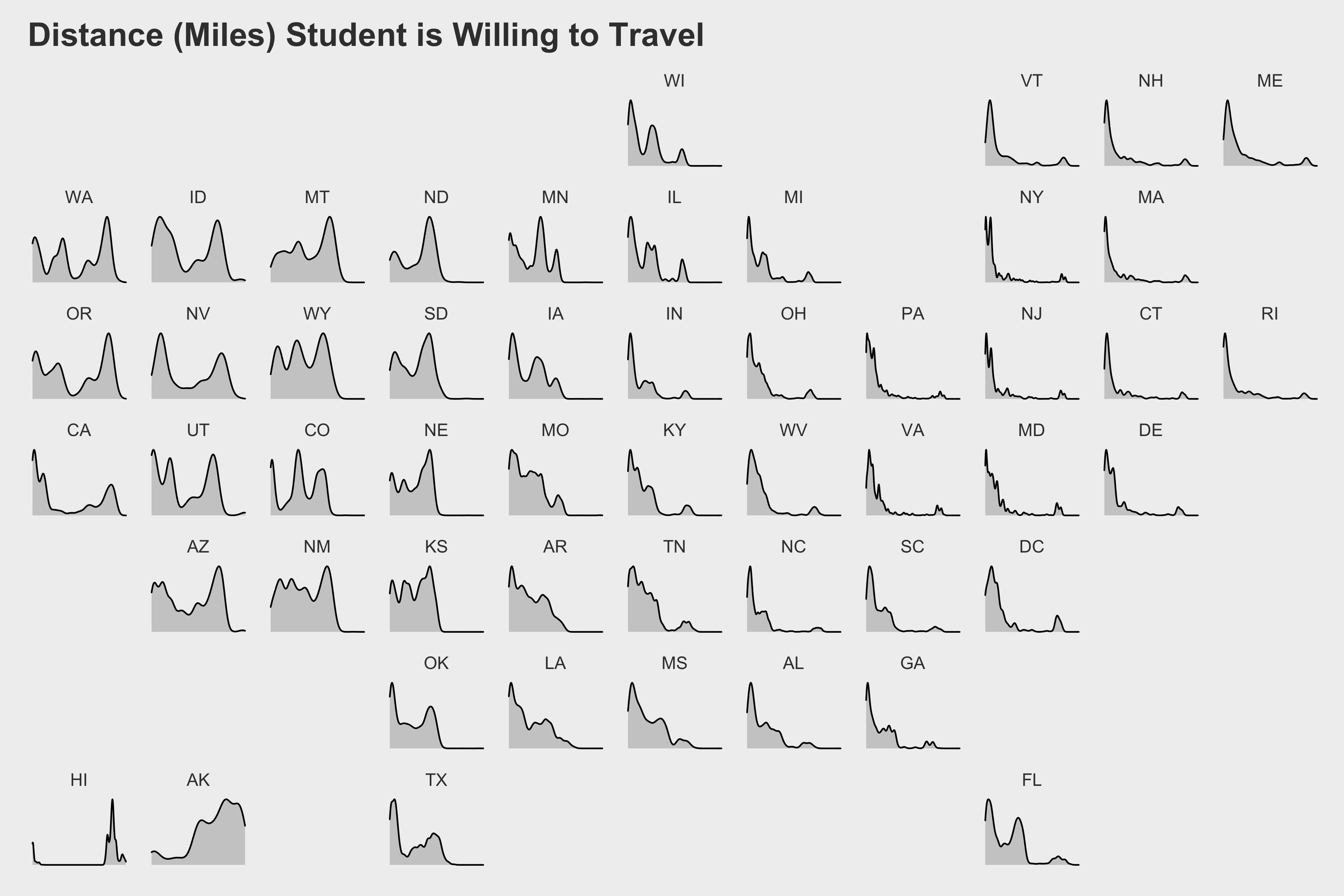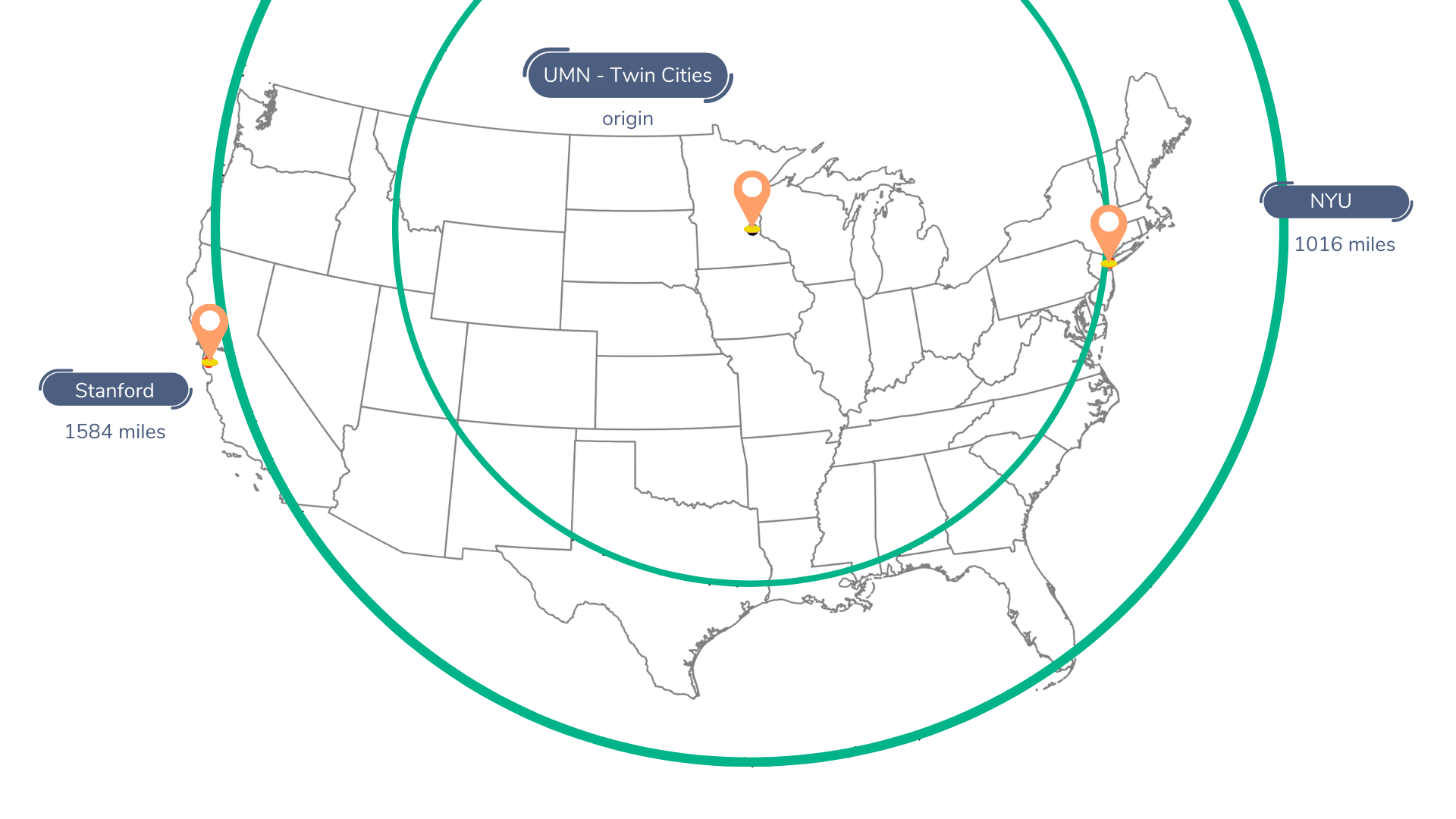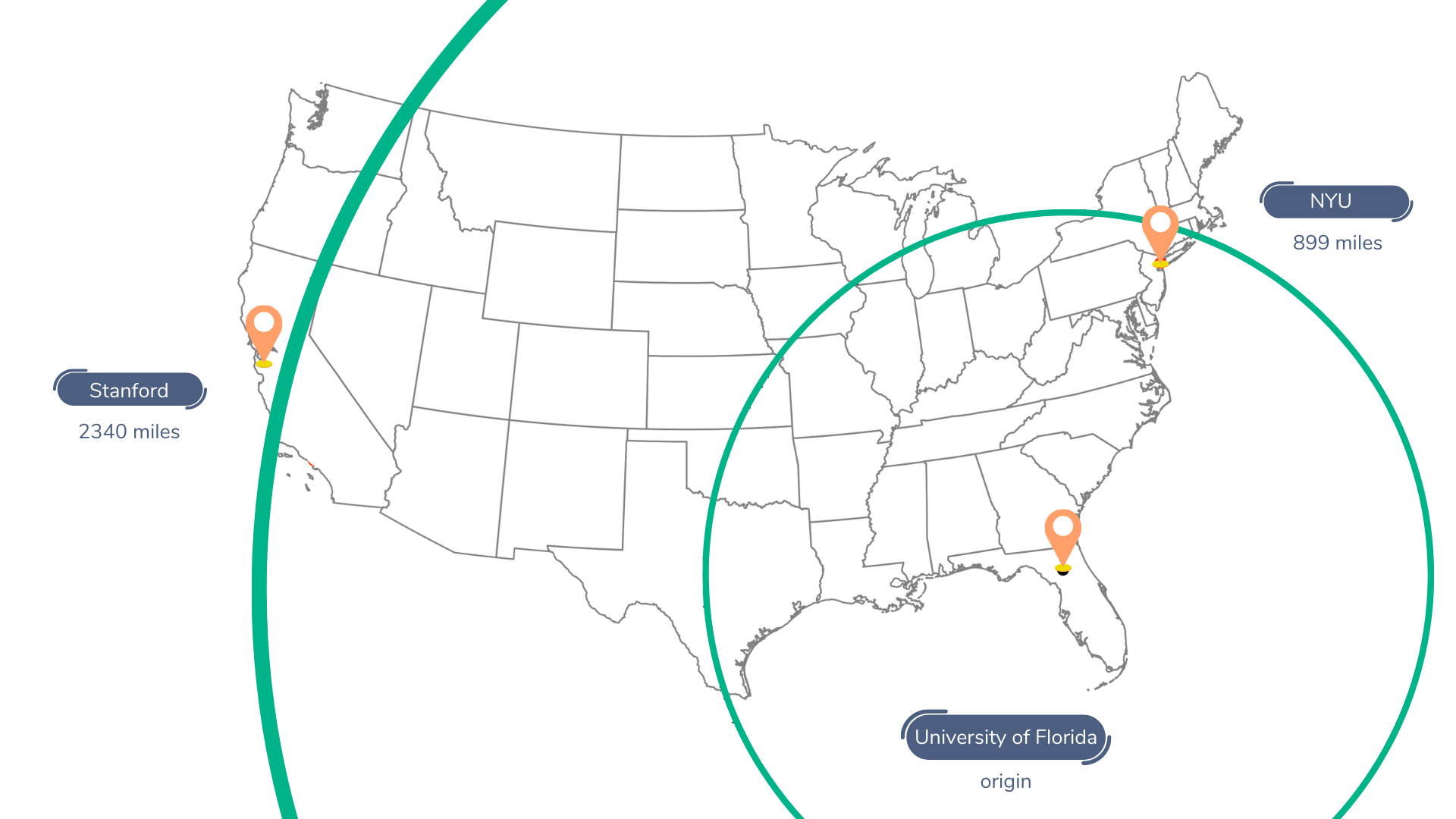Many students dream of going to college far away from home, but how far are they willing to go? Does the distance vary based on a student’s home state, their interest level in the schools, or the selectivity of the college?
Here’s what we found, and how the learnings might impact your student recruitment strategies.
Key Takeaways
To answer these questions, we analyzed CollegeVine student school lists from the high school classes of 2021 and 2022. We calculated the distance between each student’s home and the colleges they were considering. We found that:
- After adjusting for population density by state, the mean distance from home across all student lists was 562 miles, and the median was 486 miles.
- The median school list distance by state increases significantly as you move further West. This is because East Coast students are mainly interested in local schools, while students further West still add Eastern schools to their lists.
- There are some outliers within each region, however. For example, in the Northeast, recruiting out-of-state students from Vermont (358 mile median distance) may be easier than New York (228 mile median distance). In the Southwest, Arizona (1046) may be more promising than Oklahoma (464).
- Students are more interested in faraway schools earlier on in the admissions cycle, but ultimately decide to attend schools closer to home.
- Students are willing to travel 2.5 times further for Reach schools (<15% chance of acceptance) vs. Safety schools (>70% chance of acceptance).
Average Distance from Home Overall
| P25 Distance | Median Distance | Mean Distance | P75 Distance |
| 184 miles | 486 miles | 562 miles | 852 miles |
After adjusting for population density by state, the mean distance from home across all student lists was 562 miles, and the median was 486 miles. This represents around a 7.5-8.5 hour drive or a 1.75 hour flight, and a 6.5-7.5 hour drive or a 1.5 hour flight, respectively.
Median Distance From Home By State and Region
Alaska and Hawaii are not included in the plot because their median distances are significantly longer at 2,527 and 3,527 miles, respectively.
When broken down by a student’s home state, the average school list distance has a clear East to West gradient, with students on the West Coast willing to travel much further for college.
At first, we hypothesized that this gradient was due to college undergraduate population density. If there were more school “seats” relative to the student population density on the East Coast, students would naturally need to travel less. But, we discovered that there wasn’t a strong correlation.
So, to better understand the East to West distance gradient, we examined the distribution of distances of schools on students’ lists from a given state.
 The Northeast and Mid-Atlantic distributions show a significant concentration of distances closer to home, but as you move further west, states show two or three peaks in the distributions. This is likely due to students adding East and West Coast schools to their lists, along with schools nearby.
The Northeast and Mid-Atlantic distributions show a significant concentration of distances closer to home, but as you move further west, states show two or three peaks in the distributions. This is likely due to students adding East and West Coast schools to their lists, along with schools nearby.
For example, Minnesota’s distribution has peaks around 100 miles, 1000 miles, and 1500 miles, which would land students in-state, on the East Coast, or on the West Coast. In the following plot, we mapped the distances between University of Minnesota, Twin Cities to Stanford and NYU, which are the most popular out-of-state destinations on the East and West Coast for Minnesota students. The distances between these schools fall right near the peaks in the distribution.

For Minnesota students, the most popular out-of-state schools are: University of Wisconsin-Madison, University of Michigan, NYU, Harvard, Stanford, Northwestern, UCLA, Boston University, Yale, and UC Berkeley.
Similarly, Florida’s distribution has a peak close to home, but also around 1,000 miles away (East Coast) and 2,200 miles away (West Coast).
For Florida students, the most popular out-of-state schools are: NYU, Harvard, Duke, Columbia, Yale, Boat University, University of Pennsylvania, Cornell, Stanford, and Brown.

So, why do East Coast students mainly prefer schools close to home, while other students are exploring schools beyond their regions? It may be due to the name recognition of certain schools. Some of the best-known schools are on the East and West Coasts–think the Ivy League and the University of California system.
The Northeast often has a particular draw, being home to nearly half of the top 20 schools (as ranked by US News). The distributions show that East Coast schools are even popular with students in the far West, with Washington and Oregon showing a larger distribution of East Coast schools on student lists than schools nearby.
Median Distance from Home by College Application Phase
The above analysis was done for all schools at students’ lists, regardless of whether they ultimately applied or decided to enroll. We decided to also break the median distance down by list status, hypothesizing that students would be more ambitious in terms of distance earlier on in the decision cycle, but ultimately attend schools closer to home. We found this to be true on average for CollegeVine users in the high school class of 2021.
The list statuses are:
- Interested: the school is on a student’s list
- Applied: the student applied to the school
- Enrolled: the student enrolled at the school
These list statuses are not mutually exclusive, meaning that “Interested” includes “Interested,” “Applied,” and “Enrolled,” and “Applied” includes “Applied” and “Enrolled.”
The plot shows a clear decrease in distance at each step of the decision cycle, with the “Interested” median distance being more than 1.5 times that of the “Enrolled” status.
There are a few potential reasons that students tend to prefer closer schools as they move through the decision cycle.
For one, students may not end up applying to distant schools because they decide that it’s more convenient and cost-effective to go to college close by. Most public universities also favor in-state students, so students may ultimately get more offers from schools that are closer to home. Distant schools are also more likely to be Reach schools, where students have a low chance of acceptance.
Upon analyzing the average distances based on students’ personal chances of acceptance, we discovered that students are willing to travel more than 2.5 times further for Reach schools than Safety schools. This is likely because these selective schools have greater name recognition and strong financial aid programs.
But, since students have a lower chance of acceptance, this may explain the decrease in average distance between “Applied” and “Enrolled” because they don’t get into these faraway schools.
Even if students are accepted to faraway schools, they may choose closer schools because:
- Students have never visited campus and don’t have as strong of a connection to the school
- More distant schools may cost more (from out-of-state tuition or travel fees)
- Move-in is complicated if it’s too far to drive
- The lack of name recognition in students’ local network may lead to pressure from friends and family to pick a nearby school
- Students are more comfortable going to schools where they’ll already know people on campus
- Students are uncertain whether they’ll like living in a new region, often due to changes in weather or culture
- Students worry about homesickness
To better understand potential reasons for staying closer to home, we surveyed students from the class of 2021 who were accepted to faraway schools, but didn’t ultimately attend. One student stated: “I live in New York and I was accepted to schools in the West and South. I wanted to attend, but I got into a free tuition program in-state, so I thought it would be the better alternative because I plan on going to medical school, which will be expensive for me in the long run.”
In some cases, nearby schools may also simply be the best fit for students. One student from Texas shared with us: “My in-state school was far enough away to feel far from home without being hard to visit, in a city that I loved and wanted to live in, and one of the best schools for my major, at an extremely affordable price. In state wasn’t the reason, it was just the best school.”
Follow-up Questions
In our next post, we plan to explore the profiles of students in under-represented minority groups who are willing to travel further for school. We’ll also investigate the trends in the types of schools they’re considering. To be notified of our latest insights, subscribe to our email list below, where we’ll send weekly updates!
